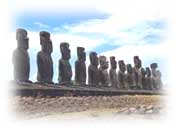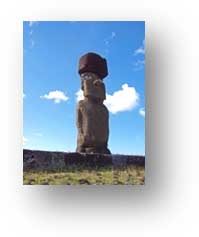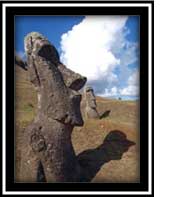EASTER ISLAND
Who Knows?
 Easter Island was settled around 400 A.D (some experts think). This is but one example of the confusion generated by archeologists' competing theories, which could not be greater if it were a society of Neolithic cavemen. Because our Expedition is sponsored by National Geographic, several archeologists are traveling with us and we met up with several more who live and work on Easter Island. The resident archeologists also acted as our tour guides and were remarkably forthright about saying that "X" was their theory but that their colleagues had a completely different view.
Easter Island was settled around 400 A.D (some experts think). This is but one example of the confusion generated by archeologists' competing theories, which could not be greater if it were a society of Neolithic cavemen. Because our Expedition is sponsored by National Geographic, several archeologists are traveling with us and we met up with several more who live and work on Easter Island. The resident archeologists also acted as our tour guides and were remarkably forthright about saying that "X" was their theory but that their colleagues had a completely different view.
So how did Easter Island get its name? The name of the island, which is the most isolated inhabited island in the world, was named by its first European visitors, the Dutch, in memory of their own day of arrival.
We learned that virtually all of the Moai (the stone statues) were pulled down centuries ago, during a period of intense political disputes. Two of our resident experts did excavations on the Island and helped re-erect a number of the Moai. Part of their work was destroyed by a tsunami in May 1960 but was partly restored with financial and construction help from a Japanese corporation. Each of the resident archeologists has his own pet theory as to what happened at any specific site. For example:
 Depending on the expert speaking, the famous Moai of Easter Island were an outgrowth of tribal competitiveness; or, they represented ancestor worship; or, the Moai were carved to protect the Island from sea invasion; or, the statues were religious edifices; or, etc. Depending on the expert speaking, the famous Moai of Easter Island were an outgrowth of tribal competitiveness; or, they represented ancestor worship; or, the Moai were carved to protect the Island from sea invasion; or, the statues were religious edifices; or, etc.
- The Easter Islanders were reduced from population of 10 to 15 thousand to a little more than a thousand a century ago. The two theories (with variations) presented to us by the two leading local archeologists were:
- The neo-Malthusians believe that the Islanders cut down all the palm trees to make skids to transport Moai from the quarry where they were carved to the platforms where they were erected, which was often miles away. The islanders subsisted on fish and tubers but were said to have outgrown their resources, at which point they turned to cannibalism.
- The counter argument is based on oral tradition, which says that islanders were kidnapped and sold into slavery in South America. When slavery was abolished, the Islanders were returned to Easter Island, at which point they were infected by smallpox. The combination of slavery and smallpox decimated the population.
- The Moai were carved at a central quarry and moved over a road that was lined on either side with logs that acted as rails for the skids. The skids were used to transport the Moai to the shore where, virtually without exception, they all face inward to the land and not outward to the sea. How the rail and skid transport worked is still a guess.

- At the quarry, the figures were carved face down and then skidded to their final resting place and raised using (at least in part) ropes made from palm fiber. Unexpectedly, most of the Moai that are visible at the quarry site are standing, perhaps because 20 feet out of the 25 to 30 foot height of the moai is buried in the earth.
- Even before the Easter Island society collapsed, the warriers, who traditionally were not of the ruling class, rose to power and began the so-called "Birdman" cult. This cult was supposed to be a peaceful method of circulating leadership. It was either accomplished by:
- There was an annual contest involving a representative from each clan. At the right time of year, those reps would swim from the island, through shark-infested waters, to some rocky outcroppings about a mile offshore. The winner was the one who finds the first bird's egg of the year, which gave his clan the leadership of the island for a year. (Some say that the contest was also a swimming contest; another theory suggests that the contestants lived on the island until the nesting began as a type of endurance test.)
- An alternate theory is that the clans got together and agreed which clan would "win" the race and assume leadership for the year.
Despite the swirl of different and often contradictory theories, the Island is interesting in and of itself. Most archeologists believe the island was settled by Polynesians, probably from the Marquesa Islands, and not (as Thor Hyerdahl believed) by mariners from South America. The Islanders certainly have the laid-back attitude associated with the Polynesian culture. The climate, at least this time of year, is warm but humid (with frequent rain showers, although we stayed nicely dry). It seems like the Islanders, like many in southern California, live to surf. However, the coastline is largely northern California-like in that it is rocky - logical since the Island was formed by volcanic action. The surfers have to surf between outcroppings of lava stone!
The hotel where we stayed, which was right on the ocean, was built 40 years ago. We were the last occupants of the old building. The wrecking ball was expected to arrive several hours after we left so that a new structure could be built (a great idea). Even without those extraordinary Moai, the Island would still be a pleasant tropical island. In fact, with only 3 to 4,000 permanent residents on a 65 square mile island, much of the island is open, unspoiled, pristine, probably a 21st century glimpse of California in the early 19th century.
< PREV | NEXT >
|
 Easter Island was settled around 400 A.D (some experts think). This is but one example of the confusion generated by archeologists' competing theories, which could not be greater if it were a society of Neolithic cavemen. Because our Expedition is sponsored by National Geographic, several archeologists are traveling with us and we met up with several more who live and work on Easter Island. The resident archeologists also acted as our tour guides and were remarkably forthright about saying that "X" was their theory but that their colleagues had a completely different view.
Easter Island was settled around 400 A.D (some experts think). This is but one example of the confusion generated by archeologists' competing theories, which could not be greater if it were a society of Neolithic cavemen. Because our Expedition is sponsored by National Geographic, several archeologists are traveling with us and we met up with several more who live and work on Easter Island. The resident archeologists also acted as our tour guides and were remarkably forthright about saying that "X" was their theory but that their colleagues had a completely different view.
 Depending on the expert speaking, the famous Moai of Easter Island were an outgrowth of tribal competitiveness; or, they represented ancestor worship; or, the Moai were carved to protect the Island from sea invasion; or, the statues were religious edifices; or, etc.
Depending on the expert speaking, the famous Moai of Easter Island were an outgrowth of tribal competitiveness; or, they represented ancestor worship; or, the Moai were carved to protect the Island from sea invasion; or, the statues were religious edifices; or, etc. 